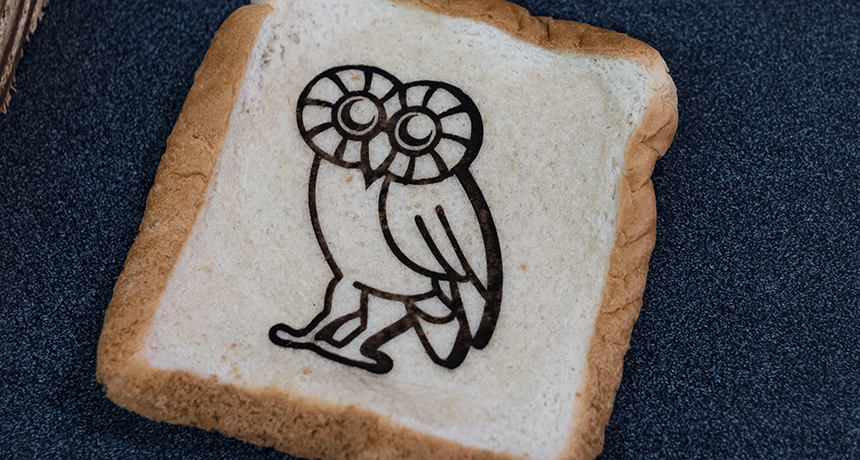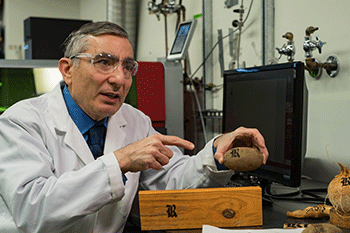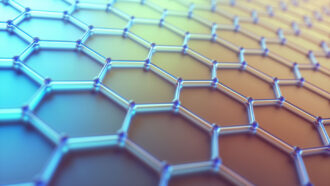Zap! Laser tattoos could create electronics to eat or wear
Scientists transform the surface of common materials into a nontoxic base for electronics

A special computer-controlled laser was used to inscribe patterned graphene onto a range of different materials, including this bread. Beyond drawing cute owls, though, scientists want to use the technology to put electronic sensors on everyday items.
Jeff Fitlow / Rice University
Imagine your favorite food. Now, imagine it tattooed with incredibly thin, edible sensors that could give you useful information. Maybe they could tell you the food’s nutritional content. Or show where and when the food was made — even how it got to your plate. That’s what scientists are working toward. With a special laser, a research team has learned to etch an ultrathin layer of carbon onto everyday materials such as foods and fabric. It’s an early, but important, step toward making a new type of electronic sensor. They could become wearable or even edible.
Yieu Chyan is a chemist at Rice University in Houston, Texas. His team uses lasers to convert carbon in the very topmost layer of different items into an incredibly useful material called graphene (GRAA-feen). It’s a single-atom-thick layer of carbon. The researchers are perfecting their tattooing technique for use on common carbon-containing materials. These include paper, cork, wood, cardboard, cloth — even foods such as potatoes and toast!

The way that carbon atoms are arranged makes graphene appear black. So tattoos created with the laser can look like drawings. But the researchers don’t add ink or anything else to the surface. The graphene forms from carbon atoms that were already part of the material.
Graphene has a honeycomb-shaped structure and is arranged in sheets just one atom thick. As a laser passes over some material’s surface, its intense energy locks together those carbon atoms on the surface, turning them into graphene. Sometimes, the laser instead jumbles up the carbon atoms. This creates a foam, which has no structure. When this happens, the researchers pass the laser over the surface again. Its second pass converts the carbon foam into graphene. Scientists call the carbon treated this way laser-induced graphene, or LIG.
Scientists have worked with LIG for a long time. “We knew it to be very useful in many applications — including sensing, water-splitting, making special coatings and batteries,” Chyan says. But previous work, he adds, only made LIG on a material known as polyimide. That’s a type of plastic. The Rice team didn’t want to be limited to that. Explains Chyan: “We wanted to be able to put LIG on a whole range of different materials.”
To do this, they changed their approach. They found a way to use multiple laser treatments to make LIG. Along the way, they discovered that the laser worked especially well on materials high in lignin. This carbon-rich substance is found in many plants. Cork, coconuts and potato skins, for instance, tattooed very well. Chyan’s team described its findings February 13 in ACS Nano.
Graphene in electronics
Graphene is not only very strong but also conducts heat and electricity well. That’s why scientists are particularly interested in using LIG for electronics. “For example,” said Chyan, “you could put LIG on cloth and make wearable electronics. Imagine a jacket that had its own power source, sensors and wiring.”
James Tour is a chemist at Rice and a co-author of the new study. He would like to see electronic sensors on foods. Manufacturers already put small computer chips on many items. One type of chip, called a radio frequency identification (RFID) tag, can store many types of information. People can retrieve that stored information by scanning the tag with a small device. Tour now envisions a day when every food “will have a tiny RFID tag that gives you information about where it’s been, how long it’s been stored, its country and city of origin and the path it took to get to your table.”
LIG tags might even help detect the presence of dangerous germs. How? Perhaps, Tour says, “they could light up and give you a signal that you don’t want to eat this.”
Jian Lin is a mechanical engineer at the University of Missouri in Columbia, who once worked with Tour. Lin is optimistic about LIG’s potential. He says the new study describes “very exciting work.” The Rice team’s improvements basically show “that anything with the proper carbon content can be turned into graphene.”
Lin’s own team is exploring how to use LIG in robotics. They are testing it for energy storage, biosensors and soft robotics, he says. That last application requires soft and bendable materials.
Chyan, too, is looking at LIG applications for robotics. He would like to give robots “touch” sensors that help them respond to how things feel. In robotic gloves, for example, they might signal how firmly to grip something so that it won’t fall — but also won’t get crushed.







